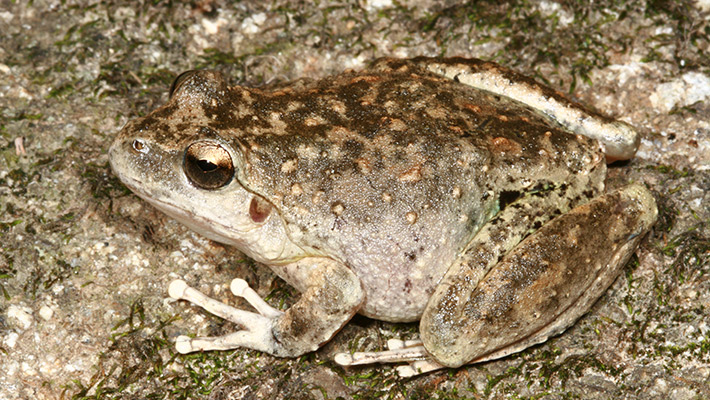Learn about the Booroolong Frog
Scientific name: Litoria booroolongensis
Classification: Endangered
Size: Males up to 40mm, females up to 55mm
Distribution: Population pockets found throughout the tablelands and slopes of NSW and Northern Victoria
Habitat: Permanent streams with rocky formations and grassy vegetation
Diet: Generalist feeder that eats mainly arthropods
Lifespan: Around 3-4 years
Primary Threats: Chytrid fungus, climate change, drought, habitat loss, weeds, introduced fish
Where are Booroolong Frogs found?
Booroolong Frogs are found in the rocky streams that flow west in the Great Diving Range, across New South Wales and Northern Victoria. Once common and widely distributed, Booroolong Frogs have disappeared from most of their range since the mid-1980s.
Ecosystem Role
Booroolong Frogs perform an important role in their ecosystems by eating river pests and being a food source for other animals. Tadpoles feed on algae and decaying matter in the bottom of the water. As they rely on healthy river systems, this species can be an important indicator of environmental changes for local scientists.
Chytrid Crisis
The disease caused by chytrid fungus has seen frog populations around the world decline, including the Booroolong Frog. It can be spread through water or direct contact with other frogs, attacking the skin and supressing immune response. Globally, around 90 species of amphibians have gone extinct due to this fungal disease. The Booroolong Frog is one of several species impacted by this disease that Taronga is working to save.
The Sunburnt Country
Booroolong Frogs only live in streams that flow year-round so are highly susceptible to droughts that dry riverbeds. Climate change is making drought events more frequent and extreme, further threatening their long-term survival.
Changes to the landscape as well as introduced fish and plant species pose further threats.
Frozen Frogs
Frog numbers are in decline and as populations shrink the genetic diversity within those populations is at risk of decreasing too. When genetic diversity in a population is high, the frogs are more resilient to change; like environmental impacts and disease. To ensure that maximum genetic diversity is passed on, our scientists are cryopreserving sperm from male frogs as part of Taronga’s CryoDiversity Bank Program. These samples are kept at -196 degrees Celsius and can remain frozen for a very long time; decades or even centuries! This frozen sperm will be strategically reintroduced into the population in later generations using assisted breeding methods to maintain the genetic diversity of the population and increase the frog species' chance of survival.
A New Hope
The 2018-2020 drought severely impacted this frog’s habitat in the northern Tablelands of NSW. Taronga collected sixty frogs from the drying ecosystem as founders for an emergency insurance population, breeding in specialist facilities at Taronga Zoo Sydney. This original population has since boomed in numbers, allowing Taronga to return over 1000 frogs back into the wild since 2023 as conditions improved. Monitoring of the released frogs shows they are growing and appear to be doing well.
Meet the Booroolong Frog
This amazing amphibian is now on display in the Amphibian and Conservation Centre (ARC) at Taronga Zoo Sydney. Your visit directly supports conservation efforts to save this species.
